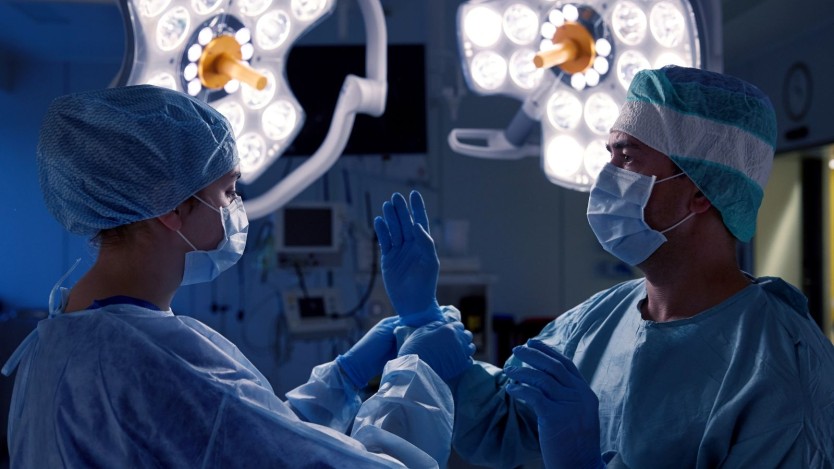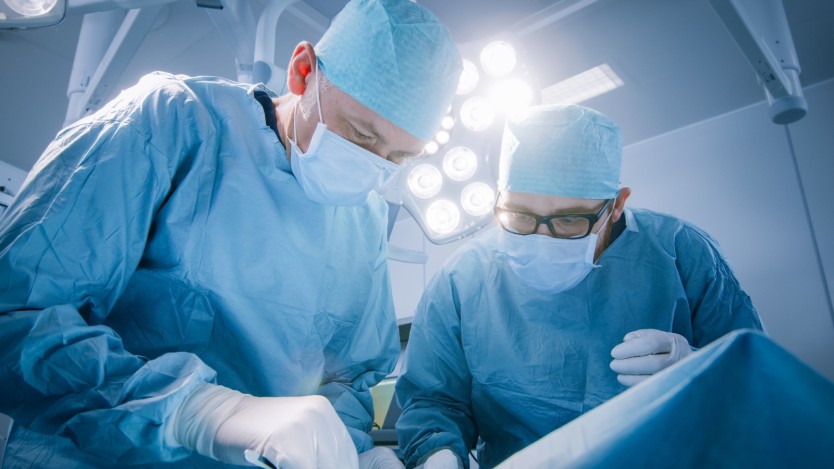What types of prostate surgery are there? TURP, Laser, Urolift

- Transurethral resection of the prostate (TURP)
- Thulium laser prostate surgery
- Advantages of the thulium laser
- Holmium laser prostate reduction: step by step
- Advantages of holmium laser prostate surgery
- Urolift prostate surgery
Benign prostatic hyperplasia affects millions of men around the world. Being a disease directly related to old age, this number increases daily due to the increase in life expectancy of the population. This is why innovation in the treatment of this pathology is very important in order to preserve a minimum quality of life in the final part of men's lives.

Do you need holmium laser prostate surgery?
Request a free and immediate appointment with our specialists in Urology
Transurethral resection of the prostate (TURP)
Transurethral resection of the prostate (TURP) is the most widely used procedure in history for the treatment of benign prostatic hyperplasia.
Its use began in the 1940s in the USA and to this day it has been considered the star surgery for treating obstructive prostate.
But despite its widespread use and proven long-term efficacy, interventions are now emerging to solve problems related to the enlarged prostate with a minimally invasive character and with the ability to operate on prostates larger than 60cc, the limit that transurethral resection of the prostate had until now (if they were larger, an open prostatectomy was performed).

Do you need TURP prostate surgery?
Request a free and immediate appointment with our specialists in Urology
Step-by-step of TURP surgery
Prior to surgery, as with any procedure for the treatment of the prostate, the patient undergoes a series of tests to determine his state of health, the exact size of the prostate and the anaesthesia to be used (this meeting is held with the anaesthetist).
Once it has been decided that the transurethral resection technique will be used to treat benign prostatic hyperplasia, the patient is admitted a few hours or a day before the operation, depending on the time the operation is to be carried out.

- In the operating theatre, the patient will be asked to remove their clothes and put on a surgical gown. You will then be asked to lie down on the stretcher and relax.
- The anaesthesiologist will then proceed to administer the anaesthesia. The anaesthetist will remain in the operating theatre throughout the operation to monitor your vital signs and regulate the sedation to avoid any problems.
- Once the patient is under anaesthesia, the surgeon proceeds to introduce a lubricated cystoscope through the urethra, which has been previously dilated.
- In order to carry out the operation, the specialist uses an endoscope with a light and a cutting instrument called a resectoscope. The surgeon will introduce this instrument through the cystoscope and, once in the prostate, will cut out small pieces and extract them. One of the advantages of this procedure is that fragments of the prostate can be obtained and analysed for possible signs of prostate cancer.
- At the same time as cutting and removing part of the prostate, the surgeon seals the blood vessels using electricity through the resectoscope.
- Finally, a catheter is placed in the bladder to facilitate the flow of urine and the patient is taken to the recovery room.
Surgery time for transurethral resection of the prostate is between 30 and 60 minutes, although it can be extended to 90 minutes in some cases.
Thulium laser prostate surgery
Thulium laser prostate surgery, which allows for the reduction of the size of the prostate through minimally invasive surgery while considerably reducing hospital stay times, postoperative recovery and complications.

This is possible thanks to the photovaporisation technique.
This technique consists of focusing the laser on the tissue to be removed by instantly heating it to a temperature of over 100 degrees, which will cause the water in the cell along with the rest of the cellular material to vaporise. In addition to this precision, some of the heat induced on the vaporised tissue is dispersed to the adjacent tissue causing a "cauterising" effect that prevents bleeding.
In this way, the hospital stay is reduced to 24 hours in the majority of cases and recovery is reduced to between 5 and 6 days approximately.
Below we explain how prostate reduction with thulium laser is performed.
Thulium laser surgery: step by step
This intervention requires hospital admission, so the patient must go to the hospital the night or a few hours before the operation, depending on the time the surgery is scheduled for.

Do you need thulium laser prostate surgery?
Request a free and immediate appointment with our specialists in Urology
- Shortly before the operation, you will be asked to remove your clothes and put on a surgical gown.
- Once in the operating theatre, you will be placed on a special table with your legs open and facing upwards. The anaesthetist will then administer a general anaesthetic and will remain in the operating theatre throughout the procedure, monitoring the patient's vital signs.
- Once the anaesthesia has taken effect, the surgeon inserts a lubricated cystoscope through the patient's penis. This instrument will allow the surgeon to insert the laser fibre and an endoscope to carry out the procedure.
- Using the thulium laser, the surgeon will vaporise the prostate tissue necessary to relieve the symptoms of benign prostatic hyperplasia and then place a catheter to remove the urine and fluid remaining after vaporisation.
Thulium laser prostate surgery lasts between 30 and 45 minutes, considerably less than conventional surgery.
Advantages of the thulium laser
In addition to solving obstructive prostate problems, the thulium laser technique offers numerous advantages that traditional surgeries do not:
- Reduced hospital stay. In prostate surgery with thulium laser the hospital stay is between 24 and 48 hours, while in traditional surgeries it is between 3 and 6 days.
- Faster recovery. Thanks to the minimal bleeding, recovery only takes 2 or 3 days at home without excessive effort.
- Minimisation of complications. With thulium laser prostate surgery, post-operative complications such as erectile dysfunction or urinary incontinence are reduced to a minimum thanks to the precision of the laser.
To find out more about prostate surgery with thulium laser, please click on this link: Thulium laser prostate surgery.
Holmium laser prostate reduction: step by step
The procedure for the treatment of obstructive prostate with holmium laser is performed under general anaesthesia and will require hospital admission.
Admission may take place the night before or the day of surgery depending on the time the surgery is scheduled.

Do you need holmium laser prostate surgery?
Request a free and immediate appointment with our specialists in Urology
Remember that the patient will have previously had a consultation with the anaesthesiologist in which the type of anaesthesia specific to the patient will be established.
- In the room before the operating theatre, the patient is asked to undress and put on a surgical gown for the operation.
- The patient is then taken to the operating theatre, positioned on the stretcher and the general anaesthesia is administered. It is important to mention that the anaesthesiologist remains in the room throughout the operation, monitoring vital signs and anaesthesia levels.
- When the anaesthesia has taken effect, the surgeon will insert a properly lubricated cystoscope through the urethra. This instrument will allow the doctor to reach the prostate with the laser fibre and perform the reduction.
- To perform prostate enucleation with the holmium laser, the surgeon will use the laser beam to separate the prostate adenoma, which is the overgrown tissue, from the prostate capsule.
- As he separates the adenoma from the capsule, the surgeon uses the laser to perform a haemostasis effect, similar to cauterisation of a wound, which prevents bleeding into the surrounding tissue.
- In order to remove the excess prostate tissue, the doctor inserts two lines of saline to distend the bladder and do so comfortably. A surgical instrument called a morcellator is used for this purpose.
- The result of the procedure is usually a completely empty prostate capsule.
The duration of the holmium laser prostate operation is between 30 and 45 minutes.

Advantages of holmium laser prostate surgery
In addition to relieving the symptoms of benign prostatic hyperplasia, the notable advantages of holmium laser intervention over traditional surgeries are:
- Hospital stay of 1 to 2 days, as opposed to 3 to 10 days for TUR and open prostatectomy.
- Full recovery at home in 3 to 4 days after surgery.
- Surgery takes only 30 to 45 minutes, depending on the patient.
- Minimised bleeding due to the haemostatic effect of the laser.
- Reduced likelihood of erectile dysfunction or urinary incontinence.
To find out more about holmium laser prostate surgery, click on the following link:
Urolift prostate surgery
Urethral release prostate surgery fulfils this purpose as it is a surgical technique that allows symptomatic relief of benign prostatic hyperplasia while preserving full sexual function, unlike traditional or laser procedures where there is the possibility of retrograde ejaculation.

Do you need urolift prostate surgery?
Request a free and immediate appointment with our specialists in Urology
In this regard, postoperative complications also include erectile dysfunction and urinary incontinence, which are minimal in laser operations and quite likely in TUR and open prostatectomy.
Urethral release procedure with Urolift system takes only 15-20 minutes.
The main characteristic of the urethral release prostate surgery is that it is an outpatient operation, so the patient does not require general or regional anaesthesia, only sedation. Below we explain step by step how the urethral release surgery is performed with Urolift system.
Urethral release surgery (Urolift System): step by step
- The patient is instructed to undress and put on an operating gown provided by the medical team.
- Once inside the operating theatre, the patient will be placed in the lithotomy position (the position in which women are placed at the time of delivery) on the stretcher. After this, the anaesthetist will administer sedation so that you do not feel anything in the area to be operated on.
- When the sedation takes effect, a lubricated cystoscope is inserted through the penis and into the prostate. Using this instrument, the surgeon inserts the urolift device into the prostate.
- He then presses on the anterolateral prostate lobe and extracts a needle that passes through it until it reaches the prostate capsule (tissue that covers the gland).
- Once through, he deploys a tab and retracts the needle while a thread, specially designed not to break and not to degrade, comes out of the needle and is placed in the perforated area.
- Finally, while the surgeon maintains pressure with the urolift device on the anterolateral lobe, he places a urethral clip that will hold the prostate tissue in place, allowing the urethral duct to remain free.
- This process is performed on both sides as many times as necessary until urethral release is achieved. Normally 2 to 6 implants are needed to solve the problem of an obstructive prostate with the Urolift System.
- One of the main advantages of this surgery is that immediately after the surgical intervention the surgeon can insert an endoscope through the urethra and check that the procedure has worked.
- After all the implants have been placed, the patient leaves the operating theatre and remains in hospital for a couple of hours until he or she recovers from the sedation and can leave the centre the same day on his or her own feet.

Advantages of Urolift System surgery
The main advantage of the prostate urethral release operation is the relief of the bothersome symptoms caused by benign prostatic hyperplasia. However, this is not the only advantage of this operation, as thanks to its outpatient and minimally invasive nature, it allows the patient to obtain numerous advantages that other operations do not offer:
- Tissue damage is minimal, so it is possible to retain full sexual function, including ejaculation, which is very difficult with other procedures.
- Recovery and symptom relief is immediate. The patient notices an improvement in symptoms immediately after the operation, with complete improvement in the results within two weeks of the operation.
- Because there is no bleeding, catheterisation is not necessary in most cases.
- The patient can return to sexual activities from the second week after the operation.
- The hospital stay is reduced to a couple of hours after the operation, until the sedation wears off. After that, the patient leaves the hospital on his or her own.
Medical disclaimer: All the published content in Operarme is intended to disseminate reliable medical information to the general public, and is reviewed by healthcare professionals. In any case should this information be used to perform a diagnosis, indicate a treatment, or replace the medical assessment of a professional in a face to face consultation. Find more information in the links below:
